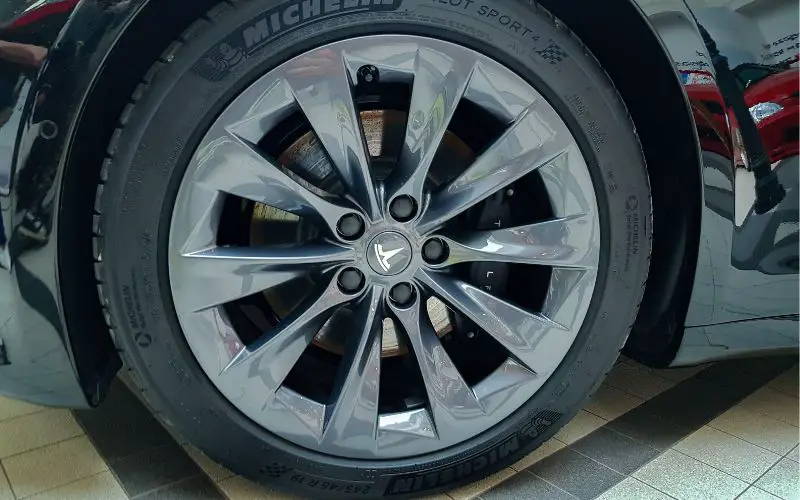Tesla Tire Pressure: All You Need To Know
Last updated on September 12th, 2023 at 03:04 am
Tires are among the most fundamental parts of vehicles as they carry all the weight. Thus, tire maintenance is essential even with electric vehicles like Tesla.
When handling Tesla tire maintenance, a crucial piece of information you must remember is your tire pressure.
The need for this information thus brings us to the question of how to check for Tesla tire pressure.
If you’re one of the curious minds, hang tight. You’ll find out soon enough.
You can check Tesla tire pressure in different ways on your Tesla car. The first and surest method is to open the driver’s door, locate the panel and find a label with an inscription of the PSI. Alternatively, you can look through your Tesla’s user manual for the appropriate tire pressure and other related information.
This article has all the information you need concerning Tesla tire pressure and where you can find the tire pressure. It also covers how to increase the tire pressure using air.
What Is the Recommended Tesla Tire Pressure?

The average tire pressure for all Tesla vehicles is 40-45psi. Although that’s the recommended average pressure, it’s not unique to all models of Tesla motors.
Knowing the correct tire pressure for your Tesla model gives you a clue on how to manage the tires better when they’re flat.
Driving your Tesla with low pressure is disadvantageous and can lead to puncture by nails or other foreign bodies.
Hence, sticking to the pressure value that’s good for your wheels is necessary. So, to prevent tire problems, you need to know the exact PSI your Tesla requires.
This table shows the various Tesla models with their accurate levels of recommended tire pressures;
| Tesla Model | Tire Pressure |
|---|---|
| Model Y | 45psi |
| Model X | 45psi |
| Model S | 45psi |
| Model 3 | 42psi |
Additionally, a simple way to determine the correct pressure for your Tesla is to check the user’s manual.
Tesla keeps all information available, so you don’t have to go through stress to find them.
Another way of discovering the pressure of air your tires need to run optimally is to check the center of the driver’s door panel.
You’ll find a label with inscriptions on the proper tire pressure for your Tesla car.
Also, stick to the latter when you buy extra tire accessories with different tire pressures from the one on the driver’s door.
Tire pressures differ depending on the model of accessories you find, but the one that’ll work for your vehicle is the one on the label.
So check your vehicle and note the tire pressure to stick with; driving the vehicle with too little or too much pressure will affect the tires.
How Can I Check My Tesla Tire Pressure?
To check your Tesla tire pressure simply, check your owner’s manual for that information. Alternatively, you can check the tires; they frequently have pressure inscriptions.
Whatever tire pressure is on the user manual is the correct pressure that your vehicle should operate on.
Tesla is strict about creating particular models of vehicles with different tire pressures to give distinction to Tesla models.
So aside from the owner’s manual, the recommended Tesla tire pressure is on the wheels.
All you need to do is inspect the body of each rear and front wheel for the tire pressure of your car model.
The tire pressure on the wheels should be the same as on the infotainment screen and the driver’s door.
That said, the surest way of getting the appropriate tire pressure for your vehicle is from the vehicle’s body.
Furthermore, written on the jamb bar of the driver’s door is an information label containing all information about the proper tire pressure from your vehicle.
Please note that there may be a disparity between the information label’s tire pressure and the one on the tires.
That commonly occurs when you buy additional tire accessories that didn’t initially come with the Tesla. In such a scenario, stick to the pressure requirement on the information label.
Now, the next thing on your mind is locating the pressure information label. Don’t worry; I’ve got you!
Please follow these steps to find that pressure label.
- Open the driver’s door.
- Check the middle of the door pillar.
- There, you have your tire information label hanging out.
- Read through to find what you need.
Also, the pressures on the rear and front wheels sometimes differ. However, the pressures on the driver’s door will guide you.
The wrong tire pressure will harm the wheels and jeopardize your safety. So, to avoid risks, it’s best to go with the information on the door’s label.
Another reliable means of checking your Tesla pressure is via the Tesla App. You can log into your Tesla App to get information about the tire pressure.
Nonetheless, if you check all these and still don’t find the tire pressure, contact the Tesla support center for help. They’ll give you all the information you need.
Alternatively, you can drive your car to any Tesla dealer shop for help on how to go about checking the tire pressure.
Does Tesla Show Tire Pressure?
Yes, Tesla shows its tire pressure because it’s a piece of vital information users need to know.
Below are some places you can see the tire pressure.
#1. Infotainment Screen
You’ll find Tesla tire pressure in the infotainment screen, but that only works when you’re driving.
The tire pressure configuration is such a way that it goes off when you’re not in motion.
That’s because it works with a system of batteries that need saving when the car is stationary, having no use for it.
Hence, checking for pressure will be challenging if the car is parked, except when you keep the car in motion.
#2. Tesla App
That’s an alternative way of finding out the tire pressure of your Tesla vehicle aside from the infotainment screen.
All you need to do is log into the Tesla App on your smartphone and select the tire pressure option for information.
You can do that while driving to see the state of the pressure your vehicle’s tires are running.
However, you may notice that sometimes the tire pressure fails to pop up while driving with the App turned on; an easy fix is to keep the Tesla App on and drive a considerable distance.
Doing that gives the App enough room to adjust to the vehicle’s state to show you the tire pressures.
Please note that if you have Tesla accessory wheels, the pressure on the label will differ from that on the tires. However, that doesn’t call for an alarm; follow the pressure on the label.
That’s the recommended pressure gauge for your vehicle rather than the accessory tire pressure.
In other words, different tires come with different pressure inscriptions, but the one you find on the door panel is unique for your vehicle.
There are other ways to check the tire pressure of your vehicle; these include the body of the tire and the jamb panel on the driver’s door.
Finally, you can check out the user’s manual for more information relating to tire pressure in your Tesla.
Can You Increase Tesla Tire Pressure with Air?
Yes, you can increase the Tesla tire pressure with air anytime the pressure drops, requiring a refill.
To do that, locate the tire valve and install a pressure gauge to measure the tire pressure.
Pumping air into the valves can increase the tire pressure, but you should take caution while at it.
Moving on, to inflate air into the tires, please follow these steps:
- Locate the valve cap that’s on the tires of your vehicle.
- Find the metallic stem on the valve cap.
- Install a valve gauge and measure the pressure to be sure of what you’re about to pump in.
- Now you can either increase or decrease the air you pump in.
While inflating your tire’s air pressure, please note that the metal stem on the pressure valve is for air adjustment.
Increasing your vehicle’s tire pressure is good because driving with deflated tires will cause them to deteriorate quickly.
Furthermore, proper pressure maintenance is necessary as it elongates your tires’ lifespan and keeps your vehicle in a prime state.
Also, it aids your handling of the car, giving you a good range of movement. Finally, having the right amount of pressure in the tires also reduces the risk of tire wear and tear.

Hey, I’m Michael Davis, a 35-year-old with a degree and a love for cars and tech. Since I was a kid, cars have been my thing—so much that I even thought they ran on magic beans! Fast forward, and I’ve built Vehicle Army, your one-stop-shop for easy-to-understand car facts.







